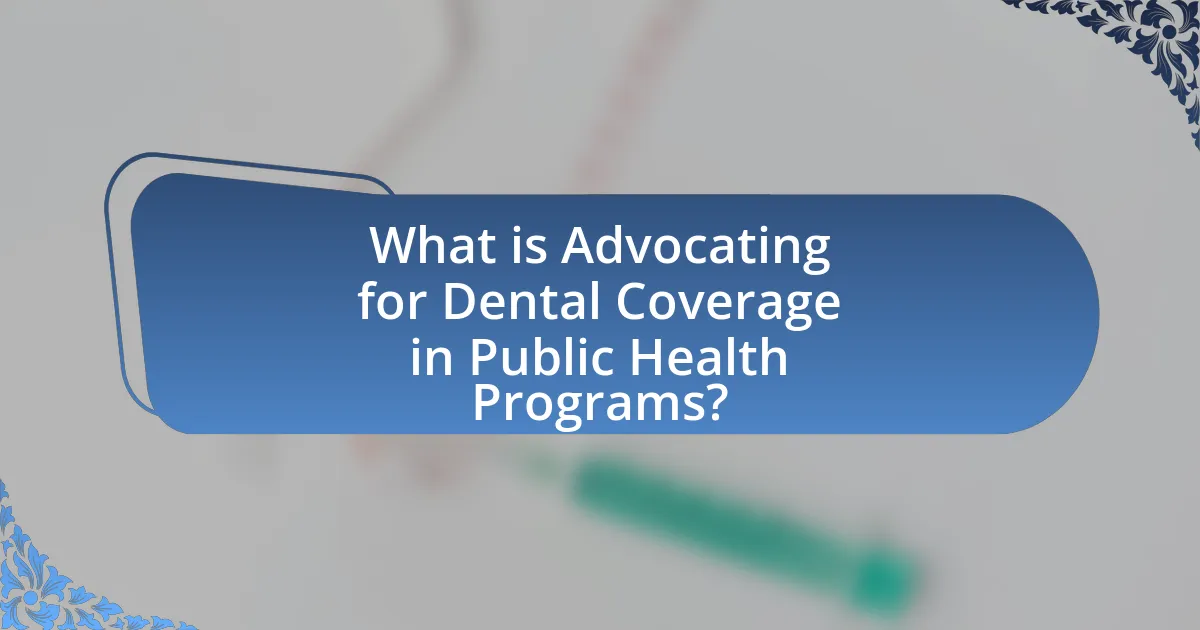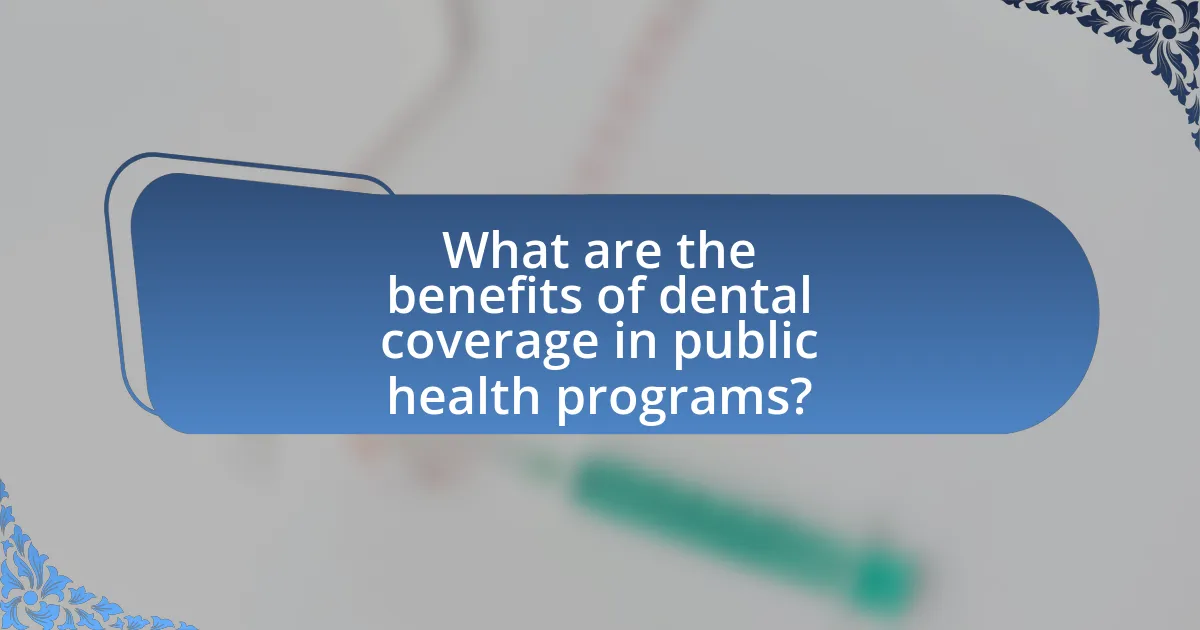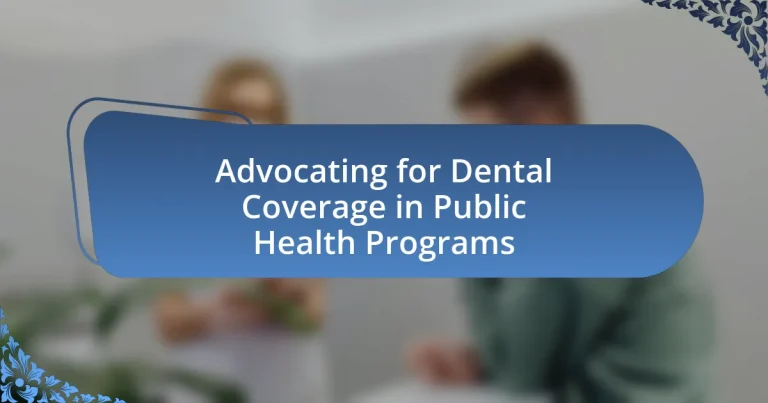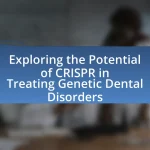Advocating for dental coverage in public health programs is essential for ensuring access to dental care for underserved populations, as oral health is closely linked to overall health outcomes. The article highlights the importance of dental coverage in preventing oral diseases, reducing healthcare costs, and addressing health disparities, particularly among low-income individuals. Key stakeholders in this advocacy include dental professionals, public health organizations, policymakers, and non-profit groups, all of whom play vital roles in promoting comprehensive dental coverage. The article also discusses the challenges faced in advocacy efforts, such as funding limitations and misconceptions about dental health, while outlining strategies for effective advocacy and the economic benefits of preventive dental care.

What is Advocating for Dental Coverage in Public Health Programs?
Advocating for dental coverage in public health programs involves promoting policies and initiatives that ensure access to dental care for underserved populations. This advocacy is crucial because oral health is integral to overall health, yet many individuals lack adequate dental insurance, leading to untreated dental issues and increased healthcare costs. Research indicates that expanding dental coverage can improve health outcomes and reduce disparities, as seen in programs like Medicaid, which provides dental benefits to low-income individuals, resulting in better oral health and reduced emergency room visits for dental issues.
Why is dental coverage important in public health programs?
Dental coverage is important in public health programs because it directly impacts overall health outcomes and reduces healthcare costs. Access to dental care prevents oral diseases, which are linked to systemic health issues such as diabetes and heart disease. According to the Centers for Disease Control and Prevention, untreated dental problems can lead to significant health complications, increasing the burden on healthcare systems. Furthermore, studies show that every dollar spent on preventive dental care can save up to $50 in emergency care costs, highlighting the economic benefits of including dental coverage in public health initiatives.
What are the health implications of lacking dental coverage?
Lacking dental coverage significantly increases the risk of oral health issues, which can lead to systemic health problems. Individuals without dental insurance are less likely to receive preventive care, resulting in higher rates of cavities, gum disease, and tooth loss. Research indicates that poor oral health is linked to conditions such as diabetes, heart disease, and respiratory infections. For instance, a study published in the Journal of Dental Research found that individuals with untreated dental issues are 2.5 times more likely to experience cardiovascular problems. Furthermore, the absence of dental coverage can exacerbate health disparities, particularly among low-income populations, leading to increased healthcare costs and reduced quality of life.
How does dental health impact overall public health?
Dental health significantly impacts overall public health by influencing systemic health conditions and healthcare costs. Poor dental health is linked to various diseases, including cardiovascular disease, diabetes, and respiratory infections, as oral bacteria can enter the bloodstream and exacerbate these conditions. For instance, a study published in the Journal of Periodontology found that individuals with periodontal disease are 2-3 times more likely to suffer from heart disease. Additionally, untreated dental issues can lead to increased healthcare expenditures; the American Dental Association reported that every dollar spent on preventive dental care can save up to $50 in future healthcare costs. Thus, maintaining dental health is crucial for enhancing public health outcomes and reducing overall healthcare burdens.
Who are the key stakeholders in advocating for dental coverage?
Key stakeholders in advocating for dental coverage include dental professionals, public health organizations, insurance companies, policymakers, and patient advocacy groups. Dental professionals, such as dentists and hygienists, play a crucial role in highlighting the importance of oral health and the need for coverage. Public health organizations, like the American Public Health Association, advocate for policies that expand access to dental care. Insurance companies influence coverage options and reimbursement rates, while policymakers create and implement legislation that affects dental coverage. Patient advocacy groups, such as the National Association of Dental Plans, represent the interests of individuals seeking affordable dental care, emphasizing the need for comprehensive coverage in public health programs.
What roles do government agencies play in dental coverage advocacy?
Government agencies play a crucial role in dental coverage advocacy by developing policies, funding programs, and ensuring access to dental care for underserved populations. These agencies, such as the Centers for Medicare & Medicaid Services (CMS) and the Health Resources and Services Administration (HRSA), implement initiatives that expand dental benefits within public health programs. For instance, CMS oversees Medicaid and the Children’s Health Insurance Program (CHIP), which provide dental coverage to millions of low-income individuals and families. Additionally, government agencies conduct research and gather data to identify gaps in dental care access, informing policy decisions and resource allocation. This evidence-based approach supports the advocacy for comprehensive dental coverage as a vital component of overall health care.
How do non-profit organizations contribute to this advocacy?
Non-profit organizations contribute to the advocacy for dental coverage in public health programs by raising awareness, mobilizing community support, and influencing policy changes. These organizations often conduct research to highlight the importance of dental health, which can lead to increased funding and resources for public health initiatives. For instance, the American Dental Association has been instrumental in advocating for policies that expand access to dental care, demonstrating the effectiveness of non-profits in shaping health policy. Additionally, non-profits frequently collaborate with government agencies and other stakeholders to create comprehensive strategies that address gaps in dental coverage, thereby enhancing overall public health outcomes.
What challenges exist in advocating for dental coverage?
Advocating for dental coverage faces several challenges, primarily due to limited public awareness and understanding of dental health’s importance. Many individuals do not recognize the connection between oral health and overall health, which hinders support for comprehensive dental coverage initiatives. Additionally, funding constraints pose significant obstacles; public health programs often prioritize other health services, leaving dental care underfunded. According to the American Dental Association, nearly 74 million Americans lack dental insurance, highlighting the systemic issue of access to dental care. Furthermore, political resistance can arise from differing opinions on healthcare policy, complicating efforts to expand dental coverage within public health programs. These factors collectively impede progress in advocating for necessary dental coverage reforms.
What are the common misconceptions about dental health in public health?
Common misconceptions about dental health in public health include the belief that dental health is not as important as general health, that dental issues are solely a result of poor hygiene, and that dental care is only necessary for children. Public health research indicates that oral health significantly impacts overall health, with conditions like heart disease and diabetes being linked to poor dental hygiene. Additionally, while hygiene plays a role, factors such as genetics, diet, and access to care also contribute to dental problems. Furthermore, adults require regular dental care to prevent and manage issues, contrary to the misconception that dental visits are only necessary during childhood.
How do funding limitations affect dental coverage advocacy?
Funding limitations significantly hinder dental coverage advocacy by restricting the resources available for outreach, education, and policy development. When financial support is inadequate, advocacy groups struggle to effectively communicate the importance of dental health and the need for comprehensive coverage, leading to reduced public awareness and engagement. For instance, a study by the American Dental Association found that states with higher funding for dental programs were more successful in implementing policies that expanded access to care. Thus, limited funding directly correlates with diminished advocacy efforts and poorer dental health outcomes in the community.
How can effective advocacy for dental coverage be achieved?
Effective advocacy for dental coverage can be achieved through strategic coalition-building, targeted communication, and data-driven policy proposals. By forming alliances with healthcare organizations, community groups, and policymakers, advocates can amplify their message and increase visibility for dental coverage issues. Research indicates that coalitions can enhance advocacy efforts by pooling resources and expertise, leading to more effective campaigns. Additionally, utilizing clear and compelling data, such as statistics showing the correlation between oral health and overall health outcomes, can persuade stakeholders of the necessity for improved dental coverage. For instance, studies have shown that individuals with access to dental care are less likely to experience chronic health issues, reinforcing the argument for comprehensive dental coverage in public health programs.
What strategies can be employed to raise awareness about dental coverage?
To raise awareness about dental coverage, targeted community outreach programs can be employed. These programs can include educational workshops that inform individuals about the importance of dental health and available coverage options. Research indicates that community-based interventions significantly increase knowledge and utilization of dental services, as seen in studies conducted by the American Dental Association, which found that outreach efforts led to a 30% increase in dental visits among participants. Additionally, partnerships with local health organizations can amplify messaging through social media campaigns and informational materials, further enhancing public understanding of dental coverage benefits.
How can community engagement enhance advocacy efforts?
Community engagement enhances advocacy efforts by fostering trust and collaboration between advocates and the community. When community members actively participate in advocacy initiatives, they provide valuable insights and perspectives that can shape more effective strategies. For instance, a study published in the Journal of Public Health Management and Practice found that community-driven advocacy led to increased awareness and support for public health initiatives, including dental coverage programs. This engagement not only amplifies the voices of those affected but also mobilizes resources and strengthens the overall impact of advocacy efforts.

What are the benefits of dental coverage in public health programs?
Dental coverage in public health programs significantly improves overall health outcomes by ensuring access to essential oral health services. Access to dental care reduces the prevalence of oral diseases, which are linked to systemic health issues such as diabetes and heart disease. For instance, studies indicate that individuals with dental coverage are more likely to receive preventive care, leading to early detection and treatment of dental problems, thereby decreasing the need for more costly emergency interventions. Additionally, dental coverage contributes to improved quality of life by alleviating pain and enhancing self-esteem, which can positively impact employment and social interactions.
How does dental coverage improve health outcomes?
Dental coverage improves health outcomes by facilitating access to preventive and restorative dental care, which reduces the incidence of oral diseases and their systemic complications. Access to regular dental check-ups and treatments leads to early detection of conditions such as cavities, gum disease, and oral cancers, ultimately decreasing the need for more extensive and costly interventions. Research indicates that individuals with dental coverage are more likely to receive timely care, which correlates with lower rates of chronic diseases like diabetes and heart disease, as oral health is closely linked to overall health. For instance, a study published in the Journal of Public Health Dentistry found that adults with dental insurance had significantly better oral health outcomes compared to those without coverage, highlighting the critical role of dental benefits in promoting comprehensive health.
What evidence supports the link between dental coverage and reduced health disparities?
Dental coverage significantly reduces health disparities, as evidenced by studies showing improved oral health outcomes among low-income populations with access to dental insurance. For instance, research published in the Journal of Public Health Dentistry indicates that individuals with dental coverage are more likely to receive preventive care, leading to lower rates of untreated dental conditions and associated systemic health issues. Additionally, a study by the American Dental Association found that states expanding Medicaid dental benefits saw a decrease in emergency room visits for dental-related issues, highlighting the direct impact of dental coverage on overall health equity. These findings collectively demonstrate that access to dental care through insurance is crucial in mitigating health disparities among underserved communities.
How does preventive dental care reduce overall healthcare costs?
Preventive dental care reduces overall healthcare costs by decreasing the incidence of dental diseases that require more expensive treatments. Regular check-ups and cleanings help identify and address issues early, preventing complications that could lead to costly procedures such as root canals or extractions. According to a study published in the Journal of Dental Research, every dollar spent on preventive dental care can save up to $50 in future dental treatment costs. This cost-effectiveness extends to overall healthcare, as poor oral health is linked to systemic conditions like heart disease and diabetes, which can lead to significant medical expenses. By investing in preventive dental care, public health programs can lower both dental and medical costs, ultimately benefiting the healthcare system as a whole.
What economic benefits arise from advocating for dental coverage?
Advocating for dental coverage leads to significant economic benefits, including reduced healthcare costs and improved workforce productivity. When individuals have access to dental care, they are less likely to experience severe health issues that require expensive emergency treatments. For instance, studies show that every dollar spent on preventive dental care can save up to $50 in restorative and emergency care costs. Additionally, improved oral health contributes to better overall health, which enhances productivity in the workplace. Research indicates that untreated dental problems can lead to approximately 164 million hours of lost productivity annually in the United States. Therefore, advocating for dental coverage not only promotes individual health but also yields substantial economic savings for both individuals and the healthcare system.
How does dental coverage contribute to workforce productivity?
Dental coverage significantly enhances workforce productivity by reducing absenteeism and improving employee morale. Access to dental care allows employees to address oral health issues promptly, which minimizes the likelihood of missed workdays due to dental pain or complications. For instance, a study published in the Journal of Occupational and Environmental Medicine found that employees with dental benefits reported 30% fewer missed workdays compared to those without coverage. Furthermore, when employees maintain good oral health, they experience less discomfort and distraction at work, leading to increased focus and efficiency. This correlation between dental health and productivity underscores the importance of dental coverage as a vital component of employee benefits.
What are the long-term savings associated with preventive dental care?
Preventive dental care leads to significant long-term savings by reducing the need for costly restorative treatments. Studies indicate that for every dollar spent on preventive dental services, there is a return of approximately $8 to $50 in savings on restorative and emergency care. This is supported by research from the American Dental Association, which highlights that regular check-ups and cleanings can prevent conditions that require more expensive interventions, such as root canals or extractions. Additionally, preventive care contributes to overall health, potentially lowering healthcare costs associated with systemic diseases linked to oral health issues.
How does dental coverage support vulnerable populations?
Dental coverage supports vulnerable populations by providing access to essential oral health services that they might otherwise forgo due to financial constraints. This access helps prevent and treat dental diseases, which are prevalent among low-income groups; for instance, studies show that individuals without dental insurance are less likely to seek preventive care, leading to higher rates of cavities and gum disease. Furthermore, comprehensive dental coverage can reduce overall healthcare costs by addressing oral health issues before they escalate into more serious health problems, thereby improving the quality of life for these populations.
What specific needs do low-income families have regarding dental coverage?
Low-income families require affordable and accessible dental coverage to address their oral health needs effectively. These families often face financial barriers that prevent them from seeking preventive care, leading to higher rates of dental disease. According to the American Dental Association, individuals from low-income backgrounds are more likely to experience untreated dental issues, which can result in complications and increased healthcare costs. Additionally, low-income families need coverage that includes preventive services, such as cleanings and exams, as well as restorative treatments like fillings and extractions, to maintain overall health and avoid emergency situations. Access to comprehensive dental coverage is essential for improving health outcomes and reducing disparities in oral health among low-income populations.
How does dental coverage impact children’s health and development?
Dental coverage significantly enhances children’s health and development by ensuring access to preventive and restorative dental care. Access to dental services leads to improved oral health, which is crucial for overall health, as untreated dental issues can result in pain, infection, and difficulties in eating and speaking. Research indicates that children with dental coverage are more likely to receive regular check-ups and necessary treatments, reducing the prevalence of cavities and other dental diseases. For instance, a study published in the Journal of Public Health Dentistry found that children with dental insurance had a 40% lower incidence of untreated cavities compared to those without coverage. This improved oral health positively influences children’s nutritional intake, self-esteem, and academic performance, demonstrating the critical role of dental coverage in fostering healthy development.

What are the current trends in dental coverage advocacy?
Current trends in dental coverage advocacy include a push for expanded access to preventive dental care, integration of dental services into primary health care, and increased funding for public health programs that address oral health disparities. Advocacy groups are emphasizing the importance of including dental coverage in broader health insurance reforms, as studies show that access to dental care significantly impacts overall health outcomes. For instance, the American Dental Association reports that individuals with dental insurance are more likely to seek preventive care, which can reduce long-term health costs and improve quality of life. Additionally, there is a growing focus on addressing social determinants of health that affect oral health, such as socioeconomic status and geographic location, to ensure equitable access to dental services for all populations.
How is technology influencing dental coverage advocacy?
Technology is significantly influencing dental coverage advocacy by enhancing communication, data collection, and outreach efforts. Digital platforms enable advocacy groups to disseminate information quickly and effectively, reaching a broader audience. For instance, social media campaigns have been shown to increase public awareness about the importance of dental coverage, leading to greater community engagement. Additionally, data analytics tools allow organizations to gather and analyze information on dental health disparities, which can inform policy recommendations and strengthen advocacy efforts. According to a report by the Pew Charitable Trusts, technology-driven initiatives have successfully mobilized support for expanding dental coverage in various public health programs, demonstrating the tangible impact of technology on advocacy outcomes.
What role do social media campaigns play in raising awareness?
Social media campaigns play a crucial role in raising awareness by effectively disseminating information to a broad audience. These campaigns utilize platforms like Facebook, Twitter, and Instagram to engage users, share educational content, and mobilize community support for causes such as dental coverage in public health programs. For instance, a study by the Pew Research Center found that 69% of adults in the U.S. use social media, making it a powerful tool for reaching diverse demographics. Additionally, social media campaigns can generate significant engagement; a campaign promoting dental health awareness can lead to increased discussions and shares, amplifying the message and encouraging public dialogue about the importance of dental coverage.
How can telehealth services enhance access to dental care?
Telehealth services enhance access to dental care by providing remote consultations and follow-up appointments, which eliminate geographical barriers and reduce the need for in-person visits. This approach allows patients in underserved areas to receive timely dental advice and treatment recommendations without the constraints of travel or wait times. According to a study published in the Journal of the American Dental Association, telehealth can increase patient engagement and satisfaction, as it offers convenience and flexibility, particularly for those with mobility issues or limited access to transportation. Furthermore, telehealth services can facilitate early diagnosis and intervention, ultimately improving oral health outcomes in populations that might otherwise delay seeking care.
What legislative changes are being proposed for dental coverage?
Legislative changes proposed for dental coverage include expanding Medicaid to cover comprehensive dental services for adults and increasing funding for community health centers that provide dental care. These changes aim to address the significant gaps in access to dental care, as studies show that nearly 74 million Americans lack dental insurance, leading to untreated oral health issues. Additionally, recent proposals advocate for including dental benefits in Medicare, which would provide coverage for seniors who currently face high out-of-pocket costs for dental services.
What recent policies have been introduced to expand dental coverage?
Recent policies introduced to expand dental coverage include the inclusion of dental benefits in Medicaid expansion under the Affordable Care Act and the introduction of the Children’s Health Insurance Program (CHIP) that mandates dental coverage for enrolled children. These policies aim to improve access to dental care for low-income families and children, addressing significant gaps in oral health services. According to the Centers for Medicare & Medicaid Services, Medicaid expansion has led to increased enrollment in dental services, demonstrating the effectiveness of these policies in enhancing dental coverage.
How can advocates influence policy changes effectively?
Advocates can influence policy changes effectively by employing strategic communication, building coalitions, and leveraging data-driven evidence. Strategic communication involves clearly articulating the need for dental coverage in public health programs, which can resonate with policymakers and the public. Building coalitions with stakeholders, such as healthcare providers and community organizations, amplifies the advocacy message and increases its reach. Additionally, leveraging data-driven evidence, such as studies showing the positive impact of dental coverage on overall health outcomes, provides a compelling case for policy change. For instance, research published in the Journal of Public Health Dentistry indicates that access to dental care significantly reduces emergency room visits, demonstrating the cost-effectiveness of including dental coverage in public health programs.
What practical steps can individuals take to advocate for dental coverage?
Individuals can advocate for dental coverage by engaging in grassroots campaigns, contacting legislators, and participating in public forums. Grassroots campaigns involve organizing community events to raise awareness about the importance of dental health and the need for coverage, which can mobilize public support. Contacting legislators through emails, phone calls, or meetings allows individuals to express their concerns and advocate for policy changes that expand dental coverage. Participating in public forums, such as town hall meetings, provides a platform to voice opinions and influence decision-makers directly. According to the American Dental Association, advocacy efforts can lead to significant policy changes that improve access to dental care for underserved populations.
How can community members get involved in advocacy efforts?
Community members can get involved in advocacy efforts by participating in local health forums, joining advocacy groups, and engaging with policymakers. These actions allow individuals to voice their concerns about dental coverage in public health programs, ensuring that their needs are represented. For instance, studies show that grassroots advocacy can significantly influence policy changes, as seen in the successful campaigns for expanded dental benefits in various states. By mobilizing community support and leveraging collective voices, members can effectively push for improvements in dental coverage policies.
What resources are available for individuals looking to support dental coverage initiatives?
Individuals looking to support dental coverage initiatives can access various resources, including advocacy organizations, educational materials, and funding opportunities. Organizations such as the American Dental Association (ADA) and the National Association of Dental Plans (NADP) provide information on policy changes and advocacy efforts. Educational materials from these organizations help individuals understand the importance of dental coverage in public health. Additionally, grants and funding opportunities from foundations like the Robert Wood Johnson Foundation support initiatives aimed at expanding dental access and coverage. These resources collectively empower individuals to effectively advocate for improved dental coverage.


